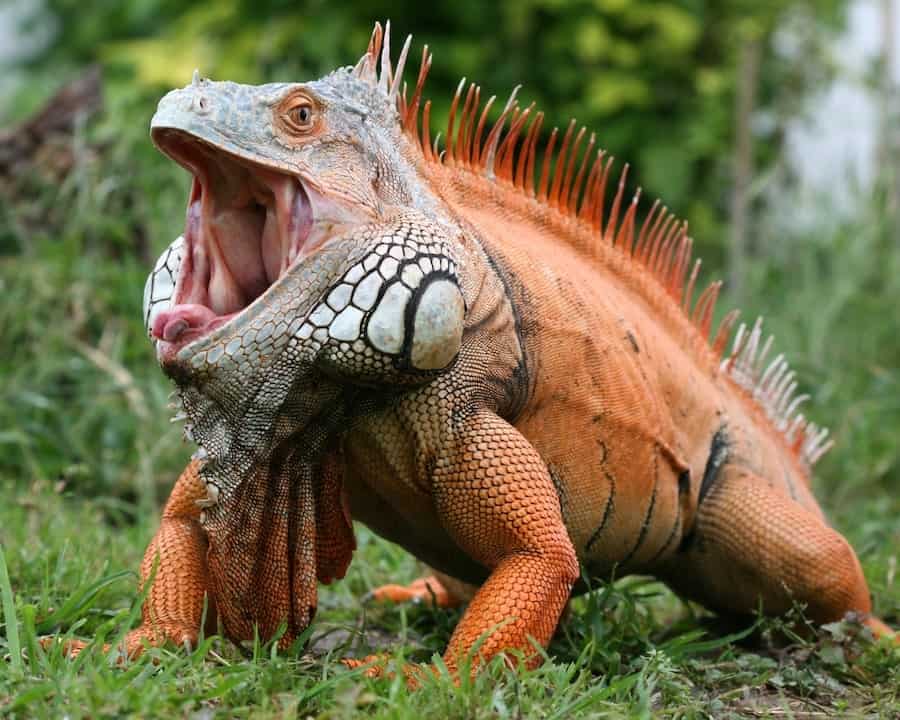If you don’t already know, iguanas use their tails to whip perceived threats. Hence, that begs the question, do iguana tail whips hurt?
As a general rule, iguana tail whips are painful. Thanks to the musculature and build, iguana tails have the potential to break the skin and cause bleeding. Full grown adult iguanas even have the potential to break a small dog or cat’s bones.
Want to avoid a tail whip? Don’t worry, I got you covered. Simply keep reading.
Do Iguana Tail Whips Hurt?
Yes, iguana tail whips can be very painful. The level of pain is, of course, going to depend on the size of the iguana, where you were hit, and the accuracy of the tail whip.
An iguana’s tail is arguably the most muscular part of its body, and, according to James Hatfield in his book, “Green Iguana The Ultimate Owner’s Manual,” makes up anywhere from 60-67% of the lizard’s total length.
In addition to whipping, the iguanas tail is used for balance and as a propeller for swimming.
A tail whip from a hatchling won’t do much to a person, a young iguana can cause serious swelling, and a full grown iguana whip can break the skin.
Referring to James Hatfield again, adult iguanas can break small animals bones. Therefore, it’s crucial to keep both your iguana and dogs away from each other unless you are supervising their interactions.
A tail whip is not the only danger iguanas pose for dogs. Check out this post I wrote called, “Can Iguanas Hurt Dogs: Keep Your Furry Friends Safe,” to read more.
Why Do Iguanas Use Their Tails As A Whip?

Iguanas use their tails as whips as their primary means of defense.
Since the tail is so long, the whip is usually the lizard’s first line of defense, although an occasional bite might precede the whip.
Yet another reason why the whip is the primary means of defense is due to caudal autonomy, which basically means the iguana can willingly detach the tail from its body without dying.
However, unlike most small lizards, iguanas can only regrow their tails during a small window of time in their hatchling phase.
If they lose their tail during their juvenile stage or as adults, they’ll be forced to live the rest of their life without a tail.
The tail’s length also means the iguana can keep the predator safely away from its body, where even a small injury can mean the difference between life and death.
However, an iguana is not afraid to use the tail whip against you or another iguana which it deems a rival.
How To Avoid Getting Tail Whipped By An Iguana
To avoid getting tail whipped by your iguana, you must learn to recognize the warning signs before being struck.
Fortunately, iguanas typically warn their perceived threats multiple times before going through with the notorious tail whip.
The warning signs include the following in no particular order:
One warning sign, and probably the most common, includes the iguana standing perpendicular to you and stiffening its tail, almost as if to say, “check out this tail, I’m not afraid to use it.”
The second warning includes a sweeping motion of the tail, like a baseball batter getting ready to swing.
The third sign involves the iguana twitching the tip of its tail. This is usually the last warning before unleashing the full fury of the tail whip.
However, iguanas provide many more signs of aggression, which you can read about in the post I wrote titled, “7 Signs an Iguana is Mad: Ignore at Your Peril.”
Can An Iguana Tail Whip Break Your Leg

An iguana tail whip cannot break your leg. Even full grown iguanas cannot break a child’s leg, as they simply do not have the power to do so.
However, they can break the skin, as previously mentioned, and they can break a small dog or cats’ leg, especially if the animal is struck near a joint.
Therefore, play it safe and try to avoid a whip, especially to the face.
What To Do If You Get Tail Whipped By An Iguana

If your iguana tail whips you, simply clean it with antibacterial soap, especially if the skin was broken or irritated.
If an iguana is infected with harmful bacteria such as Salmonella, you can very easily get infected.
The bacteria can be transmitted through any surface that comes into contact with any part of the iguana’s body. Therefore, a bite is not necessary for transmission.
If the tail whip caused bleeding and you have reason to suspect the iguana has Salmonella (especially if it was a feral iguana), you should contact your doctor as soon as possible.
How To Tame Your Iguana To Stop Whipping
The best way to stop your iguana from tail whipping you is by taming the iguana, more specifically handling it as much as possible.
Taming iguanas can take months, and in some cases, over a year. However, the more you handle the iguana the faster it will stop trying to whip you.
Learn how to correctly pick up your lizard and how to avoid reinforcing negative behavior, such as signs of aggression, and before you know it, you’ll have a docile and affectionate reptile pet that’ll leave your family and friends completely mesmerized.
For more info on how to tame your iguana, check out this post I wrote titled, “How to Tame Your Iguana The Right Way.”

